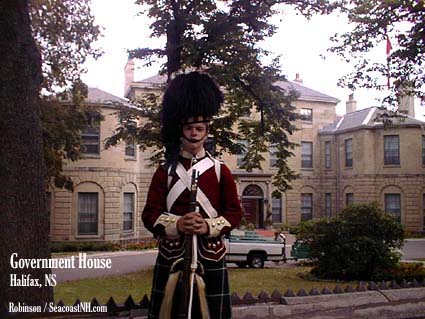|
FRESH STUFF DAILY |
|
|
||
|
|
||
|
|
||
|
SEE ALL SIGNED BOOKS by J. Dennis Robinson click here |
||
Page 2 of 2
But there was much more construction to come. John Wentworth regained his title of Surveyor of the King’s Woods in North America again in 1792, but this time he became the royal governor of Nova Scotia. That, according to the governor and his lady, required the building of a new, much grander mansion, this time in Halifax. Across a lane in the outskirts of the city then known as Pleasant Street (now Barrington Street) Sir John Wentworth set the cornerstone to Government House on September 11, 1800. Halifax was then only 50 years old, younger than its governor, born in Portsmouth, NH in 1737.
A devoted Loyalist, John Wentworth may have imagined that his new palatial home would return some of the glory lost to Britain in the American Revolution. Nova Scotians, however, did count their pennies. The local Assembly voted 10,500 pounds for the governor’s new home. As costs rose, tempers flared and John Wentworth found himself again at odds with his subjects. By his retirement in 1808 the cost to build and equip Government House was nearly three times the original sum. Wentworth moved in before the house was officially completed in 1805, and as in his Wolfeboro mansion, enjoyed only a few short years in residence. He was officially retired as governor when his successor Gen. George Prevost arrived from England accompanied by 3,000 soldiers. Another war with America was brewing and the elderly and expensive Wentworth was no longer needed. Guarded by "beefeater" style re-enactors, Government House is now the grand residence of the lieutenant governor of Nova Scotia. The high-priced house costs Canadians over $300,000 a year including maintenance, plus three office staff, a chauffeur, chef, custodian and three housekeepers, in addition to the lieutenant governor’s salary. Other than the White House, according to one source, no government home in North America has been continuously occupied longer. Three stories of stone with rounded two-story wings at each side, the mansion is designed to entertain visiting royalty – as was the Wolfeboro house – with a grand ballroom, drawing room and marble fireplaces. It is the grandest of the Wentworth homes and the most admired Georgian structure in Nova Scotia. Likely drawn from the same European design book as familiar New England structures, the building materials include a wide variety of native stone from surrounding towns. As with the empty cellar hole in Wolfeboro, a brass plaque identifies this as the former home of Sir John Wentworth. The plaque, in French and English, notes apologetically that Government House "was built to satisfy his own sense of propriety and that of his glamorous wife." Things did not end well for the Wentworths. Bored with life in Canada, Frances initiated their return to London where the governor’s pension, small by their standards, offered little in the way of luxury. As their debts rose, to avoid prison, John fled first to Liverpool, then to Halifax under the assumed name of John Wallace. Frances, by now very ill and medicated with opium, was not told of his departure. John was able to sell off some Halifax properties to pay their debts, but Frances died during his absence in 1813. Aging and ill, with nowhere left to go, John Wentworth lived out his days in Halifax where he is buried not far from his former mansion. He died at age 84 on April 8th, 1820. Four months later, on September 12 of that same year, the new owner of John Wentworth’s mansion in the wilds of Wolfeboro filled the fireplace. It was a frigid fall morning and the large fireplace was stacked with dry unused shingles. According to a nine-year old eyewitness, angry flames instantly roared up the chimney and flaming shingles landed on the roof. In three hours the mansion where John Wentworth had planned to rule the British province of New Hampshire – like its original owner -- was gone forever. Copyright © J. Dennis Robinson. All rights reserved. Author Sources: "The Romance of Government House" by James Stuart Martell, Nova Scotia Communications, 1939; "The Saga of a Palace" by Robert F.W. Meader, Wolfeboro Historical Society, 1962; An unpublished manuscript history of the Mark H. Wentworth Home by Gerald D. Foss, 1984.
Please visit these SeacoastNH.com ad partners.
News about Portsmouth from Fosters.com |
| Thursday, April 18, 2024 |


|
Copyright ® 1996-2020 SeacoastNH.com. All rights reserved. Privacy Statement
Site maintained by ad-cetera graphics

 HISTORY
HISTORY




 Two previous provincial governors had found their official housing in Halifax very satisfactory, but Wentworth reported in 1792 that the existing structure was "in Danger of falling into the Cellar". Both Sir John and Lady Wentworth demanded the best and, according to one Canadian historian, were ready to pursue their whims up to the very brink of bankruptcy." Gentlemen did not measure the cost of accommodating and entertaining British royalty, and Prince William Henry, third son of King George III, was a frequent guest at the Wentworth’s Canadian home. The young prince, popular legend says, dallied with the middle-aged Lady Wentworth while her husband trekked the wilds of Canada as royal surveyor.
Two previous provincial governors had found their official housing in Halifax very satisfactory, but Wentworth reported in 1792 that the existing structure was "in Danger of falling into the Cellar". Both Sir John and Lady Wentworth demanded the best and, according to one Canadian historian, were ready to pursue their whims up to the very brink of bankruptcy." Gentlemen did not measure the cost of accommodating and entertaining British royalty, and Prince William Henry, third son of King George III, was a frequent guest at the Wentworth’s Canadian home. The young prince, popular legend says, dallied with the middle-aged Lady Wentworth while her husband trekked the wilds of Canada as royal surveyor.














